If you’re searching for the best air dry clay for crafting in 2025, I’ve got you covered. From kid-friendly options like non-sticky, vibrant clay kits to professional-grade materials such as DAS and ACTIVA for detailed sculptures, there’s a perfect match for every project. Factors like safety, ease of use, drying time, and color variety matter. Keep exploring, and you’ll discover how to choose the ideal clay for your creative needs.
Key Takeaways
- Prioritize non-toxic, eco-friendly air dry clays suitable for all ages and safe for creative home or classroom projects.
- Look for versatile clays with vibrant color options, smooth textures, and support for detailed sculpting and finishing.
- Choose clays with quick, even drying times (24-48 hours) and minimal cracking for durable, professional-quality crafts.
- Consider storage-friendly options with resealable packaging to extend shelf life and prevent drying out.
- Select high-quality brands like DAS, ACTIVA, or kid-safe models for reliable performance across a variety of creative applications.
White Air Dry Clay for Kids, 12 Ounces

If you’re looking for a safe and mess-free air dry clay perfect for children, the White Air Dry Clay for Kids, 12 Ounces, is an excellent choice. It comes in 36 small, individually bagged pieces, making it easy to store and keep fresh. Made from soft, non-sticky, kid-friendly materials, it’s lightweight and simple to mold. The clay dries naturally in 24-48 hours into a soft foam-like texture without baking. It’s certified safe for children ages 3-11 and can be decorated with markers or paint. Plus, its design minimizes mess, making cleanup quick and effortless for parents and teachers alike.
Best For: children aged 3-11, teachers, and parents seeking a safe, mess-free, and versatile craft material for creative and educational activities.
Pros:
- Non-toxic, certified safe for young children.
- Easy to mold and shape, even with little experience.
- Mess-free design simplifies cleanup and keeps surfaces clean.
Cons:
- May dry faster than anticipated, requiring quick work.
- Slight shrinkage when dry can affect detailed projects.
- Small individual packages can be challenging to open and extract from.
Modeling Clay Kit with 24 Colors and Tools for Kids
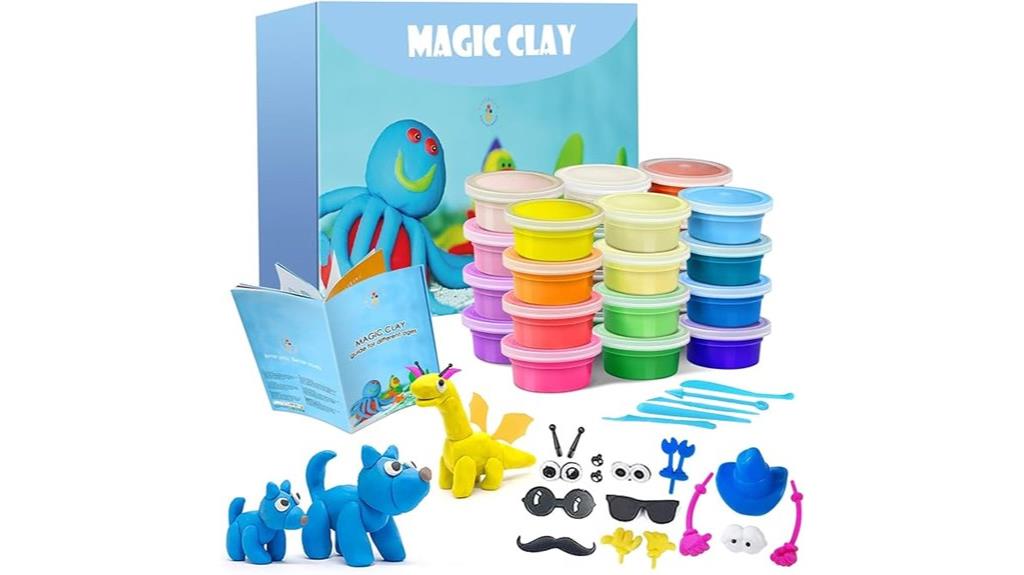
The Modeling Clay Kit with 24 Colors and Tools by ESSENSON is an excellent choice for parents, teachers, and craft enthusiasts seeking a versatile and engaging activity for children aged 3-12. It includes 24 vibrant clay containers, a project booklet, sculpting tools, animal accessories, and storage containers, totaling 62 items. The soft, lightweight clay is easy to manipulate, dries naturally within 24-48 hours, and remains soft after drying. Perfect for creative projects, it encourages sensory play, fine motor skills, and artistic expression. Customers love its vibrant colors, ease of use, and mess-free experience, making it a top pick for family fun and educational activities.
Best For: parents, teachers, and craft enthusiasts looking for a versatile, educational, and mess-free modeling clay activity for children aged 3-12 and beyond.
Pros:
- Vibrant colors and soft, pliable texture make it easy for kids to mold and create.
- Includes a comprehensive set of tools, accessories, and storage containers for endless creative possibilities.
- Dries naturally within 24-48 hours without mess or residue, maintaining softness even after drying.
Cons:
- Clay can dry out if not stored properly or used promptly.
- Mixing different colors may cause them to stick together, which might be undesirable for some projects.
- Some containers may dry out prematurely if not sealed tightly after use.
Premium Air Dry Clay, White, 10 lbs

Premium Air Dry Clay, White, 10 lbs by Old Potters stands out as an excellent choice for both beginners and experienced artists seeking a versatile, all-natural modeling material. Made from organic, Talc-free ingredients, it’s perfect for DIY projects, pottery, jewelry dishes, and decorative pieces. Its smooth texture and lively appearance give your creations a professional finish. The clay dries gradually in damp environments, producing solid, reusable artworks. With a 4.4-star rating based on 748 reviews, it’s praised for ease of use and affordability. Just remember, proper drying and support are vital to avoid cracking and ensure durable results.
Best For: hobbyists, DIY enthusiasts, and artists of all skill levels looking for an all-natural, versatile air-dry clay for creative projects and decorative crafts.
Pros:
- Easy to use for both beginners and experienced sculptors with a smooth texture and vibrant appearance
- Reusable and ideal for a variety of projects like jewelry dishes, embedded objects, and decorative pieces
- Affordable option with positive reviews and a good balance of quality and cost
Cons:
- Can crack, become brittle, or fall apart if not dried properly or supported during drying
- Some batches may weigh less than 10 lbs or exhibit inconsistencies in quality
- Requires careful handling and patience during drying to prevent issues like shrinkage and cracking
Sago Brothers Air Dry Clay 24 Colors Kit for Kids

For parents and educators seeking a safe, versatile, and engaging craft option for children, the Sago Brothers Air Dry Clay 24 Colors Kit stands out. It includes 24 vibrant colors, tools, a tutorial book, storage bags, and a gift box, making it perfect for creative projects. The soft, lightweight clay is easy to mold and dries quickly, with no mess or residue. Certified non-toxic and safe for kids aged 3 and up, it encourages imagination, fine motor skills, and color mixing. Users love its versatility for jewelry, magnets, and mini sculptures, plus the included instructions foster independent crafting and confidence.
Best For: parents, educators, and kids aged 3 and up seeking a safe, versatile, and engaging craft activity that promotes creativity and fine motor skills.
Pros:
- Vibrant color selection and easy-to-mold, lightweight clay suitable for detailed projects.
- No-mess, quick-drying design that is safe and non-toxic for children.
- Comes with comprehensive tutorials and tools to foster independent creativity and confidence.
Cons:
- Clay may dry faster than expected, requiring timely rehydration to maintain flexibility.
- Some users find small pieces can be challenging to handle without tweezers or detailed tools.
- Limited to air-drying, so projects may be less durable than kiln-fired clay for long-term displays.
Crayola Air Dry Clay (5lbs) Natural White Modeling Clay

Crayola Air Dry Clay (5lbs) Natural White Modeling Clay stands out as an ideal choice for kids, beginners, and classroom projects thanks to its soft, malleable texture and ease of use. Packaged in a re-sealable bucket, it’s simple to store and reuse, making it perfect for ongoing creative sessions. Non-toxic and safe for children aged 3 and up, this clay supports various sculpting techniques like coil, slab, and pinch. It dries within 24-48 hours, creating durable, paintable projects. Its smooth surface welcomes decorating with paints or markers, encouraging artistic expression while offering long-lasting fun with minimal mess.
Best For: children, beginners, and classroom projects looking for a versatile, easy-to-use, and safe modeling clay for sculpting and crafting.
Pros:
- Soft, malleable texture that’s easy for small hands to work with
- Re-sealable bucket for convenient storage and reuse
- Dries within 24-48 hours, creating durable and paintable projects
Cons:
- Thicker projects may crack during drying
- Slightly brittle finish once fully dry
- May require additional smoothing or repair for larger or thicker pieces
Air-Hardening Modeling Clay, 2.2 Lb. Block, White Color (387500)

If you’re looking for reliable air-hardening clay that’s easy to work with and produces professional-looking results, the DAS 2.2 lb. white modeling clay is an excellent choice. Made in Italy since 1963, it offers a smooth, porcelain-like finish without oven-baking. It’s pliable, easy to mold, and perfect for detailed sculptures, mini figurines, or repairs. Water helps weld edges and fix cracks, while drying takes about two days in low humidity. For added durability, you can oven-dry it and seal with primer or enamel. Users praise its consistency, ease of use, and high-quality finish, making it suitable for both beginners and experienced artists.
Best For: artists, hobbyists, and crafters seeking a reliable, easy-to-use air-hardening clay for detailed sculptures, repairs, and decorative projects.
Pros:
- Smooth, porcelain-like finish with no oven-baking required
- Highly pliable and easy to mold, suitable for detailed work
- Dries naturally without cracking, offering reliable results
Cons:
- Complete drying may take up to two days in low humidity conditions
- Cracks can occur if not worked in sections or if not properly sealed
- Requires sealing with primer or enamel for outdoor durability and long-term preservation
Sculpey Air-Dry White Clay (2.2 lb)

Sculpey Air-Dry White Clay (2.2 lb) stands out as an excellent choice for both beginners and experienced crafters seeking a safe, versatile modeling material. Made in Holland, it’s non-toxic and meets safety standards, making it ideal for all ages. The 2.2-pound bar offers a smooth, less sticky alternative to earthen clay, perfect for sculpting, holiday decorations, and DIY projects. It dries in about 24 hours without baking, and can be sanded, drilled, painted, or carved afterward. Its durability and fine detail retention make it a favorite for intricate crafts, with positive reviews highlighting its ease of use and low odor.
Best For: beginners, students, and crafters of all ages seeking a safe, easy-to-use air-dry clay for detailed sculptures and decorative projects.
Pros:
- Non-toxic, safe for children and adults, conforming to safety standards
- Dries quickly in approximately 24 hours without the need for baking or kiln
- Accepts a variety of paints and finishes, allowing for detailed customization
Cons:
- Slight shrinkage may occur during drying, requiring careful modeling
- Can become slightly sticky if not stored properly in airtight containers
- May require sanding or finishing for ultra-smooth surfaces after drying
ESSENSON Magic Clay – Air Dry Modeling Clay for Kids

For parents and teachers seeking a safe, easy-to-use modeling clay for young children, ESSENSON Magic Clay stands out as an excellent choice. It features 24 vibrant colors in lightweight, resealable bags, allowing kids to craft without mess or strong odors. The clay dries naturally within 24-48 hours, making it perfect for spontaneous projects. Its soft, damp texture offers extra working time, while its bounce adds fun to creations. Suitable for kids aged 3 and up, this clay boosts creativity and fine motor skills. Users praise its quality, ease of use, and bright colors, making it a top pick for family and classroom activities.
Best For: parents, teachers, and kids aged 3+ looking for a safe, easy-to-use, vibrant, and mess-free modeling clay for creative projects and educational activities.
Pros:
- Non-messy, odorless, and easy to mold, making it ideal for young children and classroom use
- Bright, vibrant colors that can be easily mixed and customized for various craft projects
- Dries naturally within 24-48 hours, allowing for spontaneous creation without baking or special tools
Cons:
- Can sometimes dry faster than expected or become difficult to work with if left exposed for too long
- Portions may arrive hardened or dried, requiring careful storage and sealing of bags to maintain freshness
- Not adhesive for hot glue, making attachment of certain elements like magnets more challenging
36 Colors Air Dry Clay with Tools for Kids and DIY Crafts
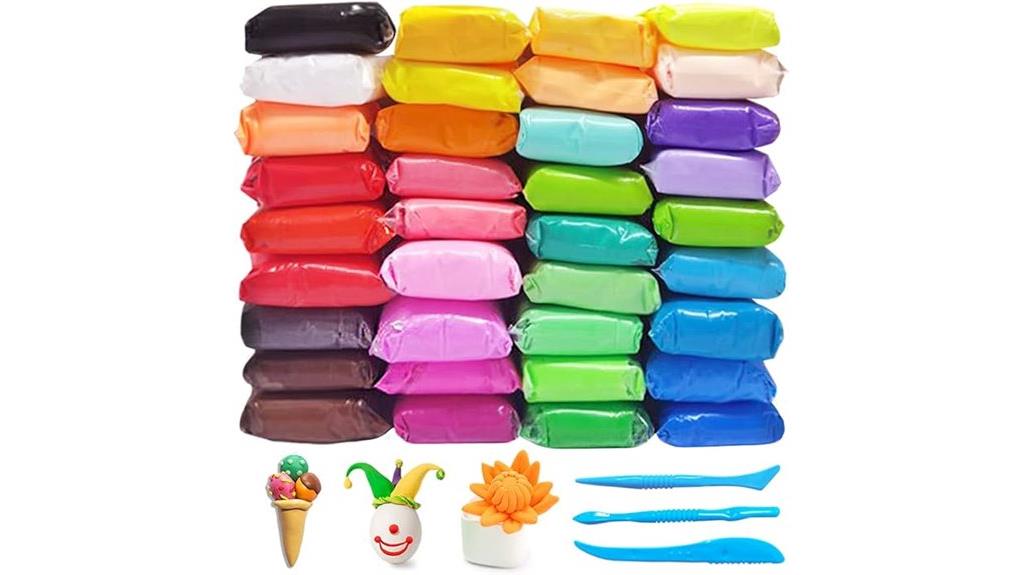
Kids and DIY enthusiasts will love the 36 Colors Air Dry Clay, which offers vibrant shades and versatile tools to spark creativity. With 36 colors and 3 modeling tools, it’s perfect for mixing custom shades and shaping small crafts. Made from eco-friendly, non-toxic ingredients, it’s safe for children over 3 years old. The soft, lightweight clay is easy to sculpt and dries within 24 hours, turning into a foam-like material. It’s ideal for miniature projects, sensory play, and creative art. Plus, it can be rehydrated with water if it dries out, making it a fun, versatile choice for budding artists and craft lovers alike.
Best For: children over 3 years old, DIY craft enthusiasts, and educators seeking a vibrant, easy-to-use modeling clay for small projects and sensory play.
Pros:
- Soft, lightweight, and easy to sculpt, making it suitable for young children and beginners.
- Vibrant color variety and the ability to mix custom shades for creative expression.
- Dries within 24 hours into a foam-like, slightly stiff material that can be rehydrated with water.
Cons:
- Fragile when dried, tears easily, and is not suitable for supporting weight or large structures.
- Small, difficult-to-open packaging may be inconvenient for some users.
- Not ideal for big or heavy projects due to its delicate nature and limited strength.
Pepy European Air Dry Modeling Clay (2.2 lb)

Pepy European Air Dry Modeling Clay (2.2 lb) stands out as an excellent choice for both beginners and seasoned crafters seeking a versatile, easy-to-use clay. I love that it starts soft and kneadable, making shaping straightforward without special tools. It dries in just 24 hours, so no oven or kiln is needed, and once dry, it’s easy to sand, paint, or polish. Made in Italy, it’s non-toxic, CPSIA-certified, and safe for kids ages 3 and up. Its smooth texture handles traditional modeling well and resists cracking, offering durable results for sculptures, holiday decor, or educational projects—all at an affordable price.
Best For: hobbyists, educators, and children ages 3 and up seeking an easy-to-use, versatile air-dry modeling clay for crafts, sculptures, and educational projects.
Pros:
- Soft, kneadable texture that makes shaping simple and accessible for all skill levels
- Dries in 24 hours without the need for an oven or kiln, saving time and equipment
- Easy to sand, paint, and polish once dry, offering durable, professional-looking results
Cons:
- Strong odor during kneading may require working in a well-ventilated area
- Some users report potential cracking or staining if not handled carefully
- Slightly more expensive than some lower-quality or less versatile clays
ReArt Natural Air-Dry Clay with Pottery Tool Set (10 lbs)

ReArt Natural Air-Dry Clay with Pottery Tool Set (10 lbs) stands out as an excellent choice for both beginners and seasoned artists seeking a thorough sculpting experience. This versatile, porcelain-based clay is non-toxic, odorless, and easy to work with, making it perfect for modeling, hand sculpting, or throwing on a pottery wheel. The 40 included tools—crafted from metal, wood, and plastic—offer a wide range of shaping, carving, and smoothing options, enhancing creativity. It dries within 24-48 hours without kiln firing, producing a durable finish. Overall, its soft texture, generous size, and extensive toolset make it a top pick for various artistic projects.
Best For: hobbyists, educators, and professional artists seeking a versatile, easy-to-use air-dry clay for sculpting, modeling, and creative projects.
Pros:
- Soft, moldable texture that is beginner-friendly and suitable for detailed work
- Includes a comprehensive set of 40 high-quality sculpting tools for various techniques
- Air-dries within 24-48 hours without the need for kiln firing, offering convenience and durability
Cons:
- Can be prone to cracking if not sealed or painted properly after drying
- Some users report crumbling or a chemically smell in older batches
- Does not fire into permanent ceramic, remaining fragile greenware if not finished properly
ESSENSON Air Dry Clay 27 Colors for Kids

For parents and educators seeking a versatile and safe modeling option, ESSENSON Air Dry Clay with 27 vibrant colors stands out as an excellent choice. It’s perfect for kids aged 3 and up, offering easy shaping without baking. The clay dries naturally in 24-48 hours, becoming soft and flexible afterward. The kit includes tools to boost creativity and makes cleanup simple since it’s scent-free, mess-free, and lightweight. Kids love the bright colors and tactile experience, while parents appreciate its safety and quick drying. With organized storage options and a high customer rating, ESSENSON’s clay is a reliable, fun choice for both classroom and home projects.
Best For: parents, teachers, and kids aged 3 and up seeking a safe, colorful, and easy-to-mold air dry clay for creative projects and educational activities.
Pros:
- Vibrant, 27-color palette that encourages imagination and color recognition
- Mess-free, scent-free, and lightweight design for easy handling and cleanup
- Dries quickly within 24-48 hours, making it ideal for display or further crafting
Cons:
- Can dry out prematurely if not stored properly or if packaging is compromised
- Slight variations in the number of colors due to packaging differences
- May be less suitable for hard sculptures as it remains soft and foam-like after drying
Air Dry Clay Kit for Kids

If you’re looking for a kid-friendly clay set that combines safety, ease of use, and creative inspiration, the Drama Planet Air Dry Clay Kit stands out. Designed for children ages 6 and up, it features non-toxic, soft, and non-sticky clay that dries naturally in 24 hours—no baking needed. The kit includes 18 colorful cans of clay, sculpting tools, a display stand, and step-by-step tutorials for 26 projects across fun themes like forests, farms, and aliens. With sealed containers for neat storage and encouraging independent creativity, it’s perfect for fostering artistic skills while providing a fun, screen-free activity that kids love.
Best For: parents and kids ages 6 and up seeking a safe, creative, and screen-free art activity that fosters imagination and fine motor skills.
Pros:
- Non-toxic, soft, and non-sticky clay ideal for children’s safe use
- Includes comprehensive tutorials and themes to inspire creativity and skill development
- Comes with sealed containers for easy, mess-free storage and a display stand for showcasing artwork
Cons:
- Requires 24 hours to dry completely, which may delay immediate display or play
- Limited to indoor use due to the natural drying process
- May need additional tools or materials for advanced projects not included in the kit
100ml Air Dry Clay Gloss Varnish and 29pcs Clay Tools Kit
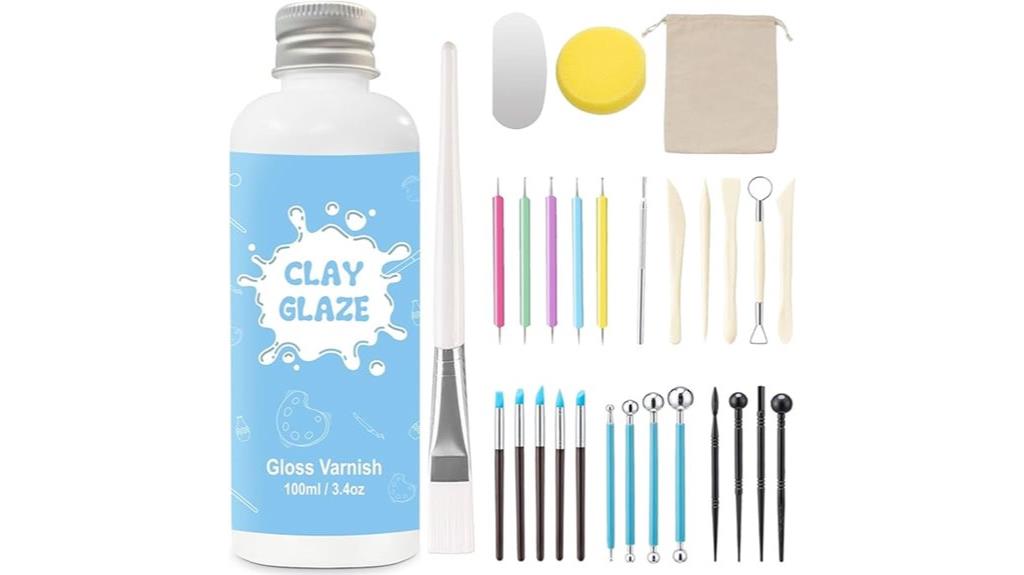
The ml Air Dry Clay Gloss Varnish and 29pcs Clay Tools Kit stands out as an ideal choice for both beginners and experienced crafters seeking a complete set to enhance their projects. The kit includes 100ml of glossy, waterproof, fireproof glaze that dries to a smooth, high-gloss finish in about 24 hours, protecting your work from cracks and scratches. The 29 tools cover carving, shaping, texturing, and trimming, suitable for various clay types. With durable metal and plastic tips, plus a practical storage bag, this set offers versatility and convenience for pottery, sculpting, and molding projects, making it a valuable addition to any craft arsenal.
Best For: Hobbyists, beginners, and professional artists looking for a comprehensive clay crafting kit with a glossy protective glaze.
Pros:
- Includes a complete set of 29 versatile clay tools suitable for various sculpting techniques.
- The 100ml glaze provides a durable, waterproof, and fireproof high-gloss finish after drying.
- Comes with convenient accessories like a storage bag, sponge, and instruction sheet for easy organization and use.
Cons:
- Some silicone tips on the tools may pop out during use, requiring careful handling.
- The kit does not include clay, so additional purchase of clay is necessary.
- The glaze takes approximately 24 hours to fully cure, which may require planning ahead for projects.
ACTIVA Supreme Artists Air-Dry Modelling, 2.2 pounds, White Clay
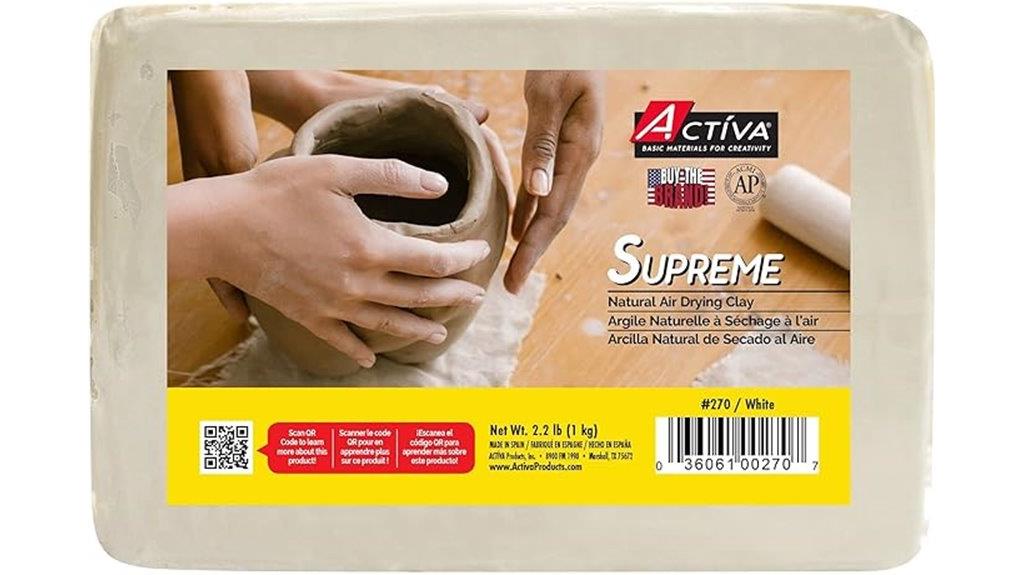
ACTIVA Supreme Artists Air-Dry Modelling Clay stands out as an excellent choice for artists and hobbyists seeking professional-quality material that’s easy to work with. Made from natural earth clay from Spain, it offers high plasticity, fine detail, and a smooth finish. Weighing about 2.2 pounds, it’s non-toxic, safe for all ages, and ideal for detailed sculptures, crafts, and educational projects. It dries within 24 hours, becoming durable and resistant to cracking. Its ability to be carved, sanded, and finished makes it versatile. Whether you’re a beginner or a pro, this clay’s quality and ease of use make it a top pick for creative endeavors.
Best For: artists, hobbyists, and students seeking a high-quality, easy-to-use air-dry modeling clay for detailed sculptures and craft projects.
Pros:
- Excellent detail and smooth finish suitable for intricate work
- Non-toxic, safe for all ages, and meets safety standards
- Dries quickly within 24 hours, with durable, crack-resistant results
Cons:
- Slight shrinking during drying can cause cracking if not properly handled
- May require water for rehydration to fix cracks or rework pieces
- Limited color options, as it is available only in white
Factors to Consider When Choosing Air Dry Clay for Crafting
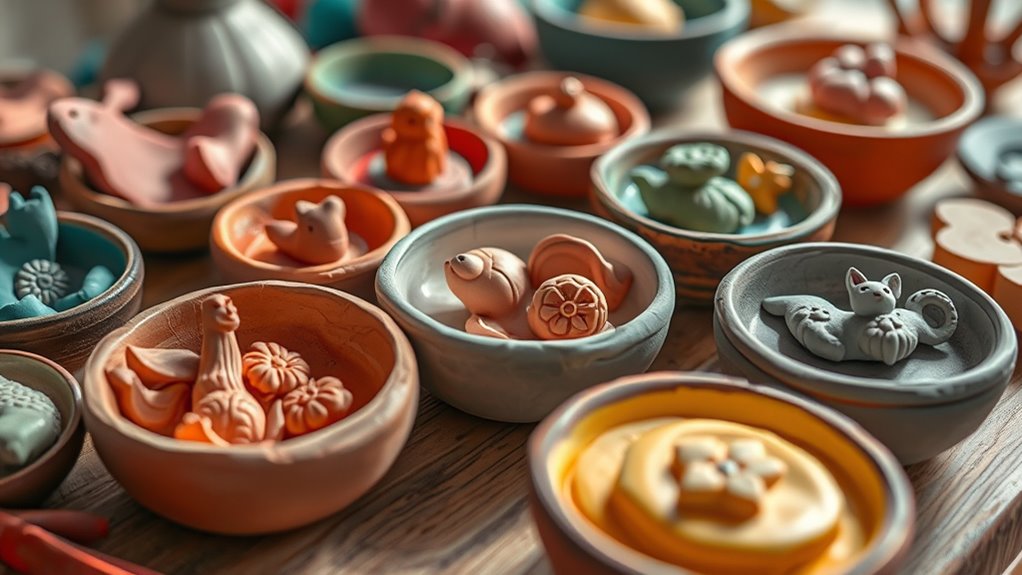
When selecting air dry clay, I focus on safety and non-toxicity to guarantee it’s suitable for all ages. I also consider how easy it is to handle, along with drying time and durability, to match my project needs. Finally, I look at color options, storage, and how long the clay will last to keep my crafting enjoyable and practical.
Safety and Non-Toxicity
Choosing the right air dry clay for your projects means prioritizing safety and non-toxicity. I always check for certifications like ASTM F-963-17 or CPSIA compliance to ensure the clay is safe, especially if kids are involved. It’s important to select products free from harmful chemicals, gluten, and allergens to prevent any reactions or health issues during use. I look for labels indicating the clay is safe for children aged 3 and up, meaning it has passed child-safety tests and poses no choking hazards. Additionally, I prefer water-based, organic, and environmentally friendly options to reduce health risks and environmental impact. Always review the product labels and safety data sheets to confirm the absence of lead, phthalates, or VOCs for peace of mind.
Ease of Handling
Selecting an air dry clay that’s easy to handle can make a big difference in your crafting experience. You want a clay that’s soft and pliable enough to mold effortlessly without applying excessive force. Good handling also means minimal stickiness, so it won’t leave residue on your hands or surfaces. It should be workable for various techniques like pinching, rolling, carving, and blending, giving you flexibility in your designs. A manageable drying time is essential, allowing you enough time to shape and make adjustments before it hardens. Additionally, the clay’s texture should support detailed work and fine features without cracking or becoming brittle during handling. Overall, choosing a clay with these handling qualities helps you craft smoothly and achieve professional-looking results.
Drying Time and Strength
Drying time is a critical factor because it directly affects how long you need to wait before your project is ready and how durable it will be once dry. Typically, air dry clay takes 24 to 48 hours to fully dry, but this varies with thickness and environment. Thicker or larger pieces may need extra time and are more prone to cracking if not dried evenly. The strength of the dried clay also varies; some formulations become sturdy enough for functional items, while others stay lightweight and more fragile. Proper, slow drying in a humid setting generally results in stronger, less brittle pieces. Supporting your project during drying and handling it carefully can prevent cracks and improve its overall durability.
Color Range Options
A wide variety of color options in air dry clay can substantially enhance your creative projects by offering more vibrant and detailed results without extra painting or mixing. With some brands offering 36 or more colors, you get a broad palette to bring complex, colorful designs to life. Choosing clay with diverse colors helps you achieve realism and aesthetic appeal directly out of the package. Additionally, individual color portions prevent waste and keep the clay fresh longer. Some kits even include special effects or metallic shades, expanding artistic possibilities beyond basic hues. Overall, the availability of multiple colors allows for greater flexibility, richer finishes, and more professional-looking crafts, making it easier to match your vision perfectly without additional steps.
Storage and Longevity
Proper storage is essential to keep air dry clay workable for as long as possible. I always store unused clay in airtight containers or resealable bags to prevent it from drying out prematurely, which extends its lifespan. Keeping the clay in a cool, dry place away from direct sunlight helps maintain its moisture and pliability over time. The longevity of air dry clay varies by brand, but high-quality options often stay workable for several months if stored properly. If my clay hardens, I sometimes rehydrate it with a little water, though it may not fully regain its original flexibility. Consistently sealing and storing it in a moisture-controlled environment reduces the risk of cracking, shrinking, or becoming unusable over extended periods. Proper storage truly makes a difference in crafting with air dry clay.
Frequently Asked Questions
How Long Does Air Dry Clay Typically Take to Fully Dry?
You’re wondering how long air dry clay takes to fully dry, right? Usually, it depends on the thickness of your project, but I find that thin pieces dry in about 24 hours, while thicker ones can take up to 48 hours or more. I always leave my creations in a well-ventilated area and check them periodically. Patience is key to achieving a strong, durable finish!
Can Air Dry Clay Be Painted After Drying?
Absolutely, you can paint air dry clay once it’s fully dry. I always wait at least 24 hours to guarantee it’s completely hardened before adding any paint. Acrylics work best because they’re vibrant and adhere well. I recommend applying a primer first for smoother finishes. Just be gentle, and avoid soaking it in water after painting to preserve your artwork’s look and longevity.
Is Air Dry Clay Suitable for Outdoor Crafts?
Imagine your outdoor garden filled with colorful sculptures. I’ve found that air dry clay can be suitable for outdoor crafts, but it depends on the type. Some air dry clays are more weather-resistant, especially if sealed properly. I recommend choosing a waterproof, outdoor-specific clay and sealing your finished piece with a clear outdoor sealant. This way, your creative outdoor project stays vibrant and intact over time.
How Do I Prevent Cracking in My Dried Clay Projects?
Cracking is a common issue with air dry clay, but I’ve found a few tricks to prevent it. I always keep the clay moist while working, avoid overworking it, and don’t rush the drying process—patience is key. I also smooth the surface gently and add a bit of water if I notice cracks starting. These steps help me achieve smooth, durable projects without cracks.
What Tools Are Best for Shaping and Detailing Air Dry Clay?
I know it’s frustrating when your detailed work doesn’t turn out perfect. For shaping and detailing air dry clay, I swear by silicone sculpting tools and fine-tipped brushes—they give me precision and control. Small clay knives and needle tools are also lifesavers for intricate designs. Don’t be afraid to experiment with different tools; I’ve found that the right ones make all the difference in bringing my creative visions to life.
Conclusion
Choosing the right air dry clay feels like selecting the perfect canvas for your imagination. Whether it’s vibrant colors or smooth textures, each option unleashes a new world of creativity. As you mold and shape your ideas, remember that your craft is a reflection of your unique vision—like a garden blooming with endless possibilities. So, pick your clay and let your creativity flourish, turning simple lumps into masterpieces that speak from the heart.









